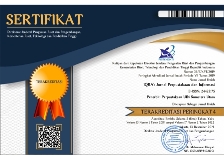Implementation Of Good Governance Principles To Increase Library Service Capacity In Sungai Kerjan Kelurahan Office In 2020
Abstract
Full Text:
PDFReferences
Dan, P., & Pendidikan, M. (n.d.). Peran Dan Tantangan Perpustakaan.
Mangnga, A. (2015). Peran Perpustakaan Sekolah Terhadap Proses Belajar Mengajar Di Sekolah. Alias Mangnga / JUPITER, XIV(1), 38–42.
Rahman, M. M. (2015). Mengaktifkan Perpustakaan Sekolah. LIBRARIA: Jurnal Perpustakaan, 3(2), 181–199.
Solikah, A. (2015). Strategi Peningkatan Mutu Pembelajaran Pada Sekolah Unggulan (Cetakan pe). Deepublish CV. BudiUtama.https://www.google.co.id/books/edition/Str ategi_Peningkatan_Mutu_Pembelajaran_P/vOmdDwAAQ BAJ?hl=id&gbpv=1&dq=Strategi+Peningkatan+Mutu+Pe mbelajaran+Pada+Sekolah+Unggulan.&printsec=frontcov er
Sugiyono. (2008). Metode Penelitian Kuantitatif. Alfabeta. Suyedi, S. S., & Idrus, Y. (2019). Hambatan-Hambatan
Belajar Yang Mempengaruhi Hasil Belajar Mahasiswa Dalam Pembelajaran Mata Kuliah Dasar Desain Jurusan Ikk Fpp Unp. Gorga : Jurnal Seni Rupa, 8(1), 120. https://doi.org/10.24114/gr.v8i1.12878
Yusuf, M. (2017). Metode Penelitian Kuantitatif, Kualitatif & Penelitian Gabungan (Edisi ke 4). Kencana. https://www.google.co.id/books/edition/Metode_Peneliti an_Kuantitatif_Kualitatif/RnADwAAQBAJ?hl=id&gbpv=1
&dq=Metode+Penelitian+Kuantitatif,+Kualitatif+%26+Pen elitian+Gabungan&printsec=frontcover
DOI: http://dx.doi.org/10.30829/iqra.v16i2.11779
Refbacks
- There are currently no refbacks.
Copyright (c) 2022 Mulia Jaya, Firmansyah Firmansyah

This work is licensed under a Creative Commons Attribution-ShareAlike 4.0 International License.
IQRA': JURNAL PERPUSTAKAAN DAN INFORMASI
Perpustakaan Universitas Islam Negeri Sumatera Utara
Jalan Willem Iskandar Pasar V Medan Estate
20371
Medan - Sumatera Utara






